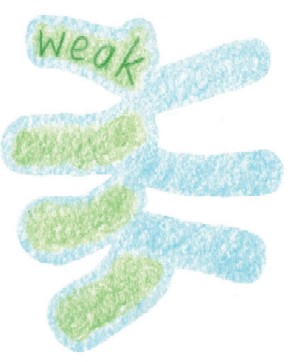

Would you like to receive publication updates from HLT? You can by joining the free mailing list today. |
Humanising Language Teaching
Year 5; Issue 3; May 03
Language Gardening
An Author's Review
David Warr 2003
I am grateful for the opportunity to review the book,
Language Gardening, which I have written and published.
The book expounds a new concept, a new way of presenting language on paper, and details how these materials, called language plants, can be used in class with students.
This is a language plant.

It has two properties:
It is non-linear – words bend round, so that we can read two sentences:
Language plants are colourful materials.
Language plants are non-linear materials.
It is colourful – words are coloured according to word class.
The background branch colour shows syntax.
Language plants are an evolution of current orthodox materials. The simplest plants are very similar to grammar and collocation boxes, but with the lines removed.
The book has 128 pages, divided into 9 chapters.
It merges properties from different teacher development books.
It is a coursebook, a practical course in how you can transcribe and use plants in class.
There are hundreds of these trowel symbols throughout the book.
They signify activities to do in class.
The book is theoretical. It covers many aspects
of language, by using language plants.
It is a resource book. It can be read linearly, in order, but each double page is free-standing and self-contained, so that it can be dipped into anywhere.

The objective when making, or transcribing, language plants is to
put lots of linguistic information – grammar, phonology, spelling –
into one material, so that it is easy to access by students.
There are 4 sentences in the plant above. What are they?
What do you think each colour represents?
Look at the i in simple, and the ea in easy.
They are written thick to show primary stress.
Look at the plant below.
There are 10 words. What are they?
Which vowels are written thick?
The verbs are written in red, with a pink background.
What does the addition of –ment do to these verbs?
What does blue represent?

The collocation plant below needs completing.
The following 6 words have to be placed on the 6 branches.
mild curry tea strong cheese spicy
Adjectives fit onto the green branches, nouns fit onto the blue.
Which noun collocates with weak?
Write it on the top right branch.
Which is the other adjective that collocates with this noun?
Write it on the second green branch.
Which other noun collocates with this adjectives?
Write it on the second blue branch.
Carry on with the last few words.

This plant offers different ways to thank someone.
I means informal
P means polite

Chapter 1 is the introduction. It gives an overview of the book.
Chapter 2 discusses what language is, using the metaphor of a plant. By looking at real plants, we can better understand the concepts of grammar, functions and context.
Chapter 3 demonstrates how to write, or transcribe, language plants on paper; how big to write each letter, how to bend them round, how to add colour and phonology.
Chapter 4 looks at word plants, comparing, for example, ship and sheep, and how we can make the morphology of a word easier to see.
Have a go at transcribing a plant using these words:
nation national nationality nationalise nationalisation
denationalise denationalisation renationalise renationalisation
Chapter 5 explains syntax in detail: noun, adjective, prepositional
and verb phrases, and also adverbials and clauses.
Transcribe:
antique clock; old clock; antique vase; old vase
Chapter 6 looks at function plants, like the thanking plant above.
Chapter 7 considers the practical details of using plants in the classroom. We look at how we learn, and how plants can be used in any teaching situation.
Chapter 8 gives ideas for practising the four skills with plants.
Chapter 9 gives 5 lesson plans.
I have tried to put into practice what I know about learning.
Pages are visual, and information is in bite-sized chunks.
Many, on first seeing the book, comment on how nice it looks.
Learning is that much easier, and more fun, when we are in this frame of mind.
If you wish to look at two page samples,
you can visit the Language Garden website at
David Warr